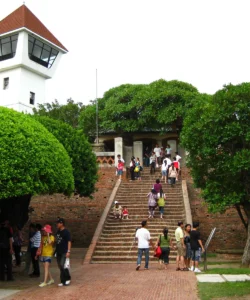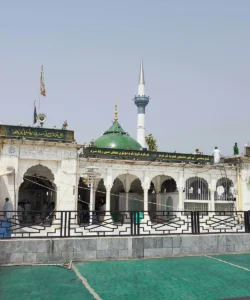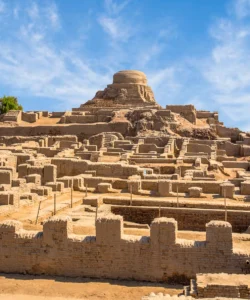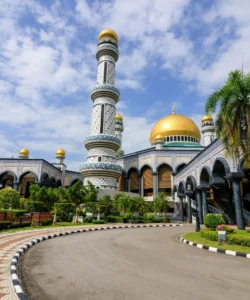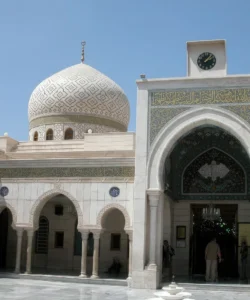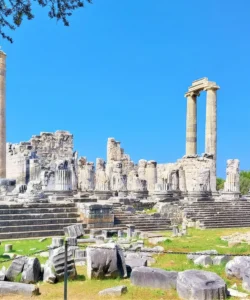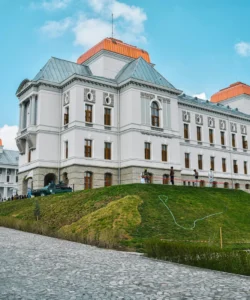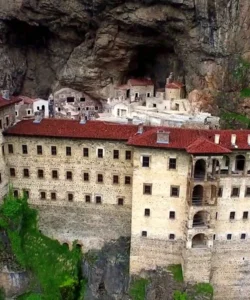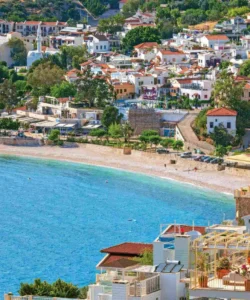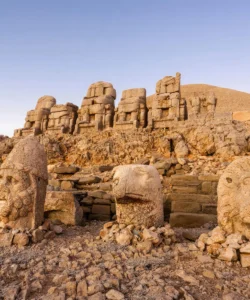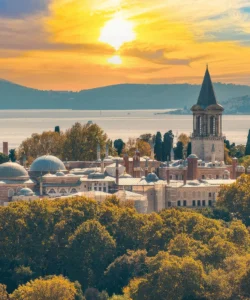Ephesus was one of the largest and most important ancient Greek and Roman cities in the Mediterranean world, located on the western coast of Asia Minor (modern-day Turkey). It served as a major port, a significant commercial hub, and a vital center for both pagan worship (especially of Artemis) and early Christianity. Its well-preserved ruins offer a fascinating glimpse into centuries of history.
Listen to an introduction about Ephesus
Name and Address
- Name: Ephesus (Ancient Greek: Ephesos)
- Address: The archaeological site is located near the modern town of Selçuk, within the İzmir Province, Turkey.
How to Get There
Ephesus is a highly accessible and popular tourist destination in Turkey.
- By Air: The closest airport is Izmir Adnan Menderes Airport (ADB), approximately 75 km (47 miles) from Selçuk. From the airport, you can take a train, bus, or taxi to Selçuk.
- By Road: Selçuk is well-connected by intercity buses from major Turkish cities. Once in Selçuk, local minibusses (dolmuş) or taxis can take you to the Ephesus archaeological site. Many organized tours also depart from nearby cruise ports like Kusadasi.
- By Train: You can take a train from Izmir to Selçuk.
- On-Site: The site is extensive, and it’s recommended to wear comfortable shoes. There are two main entrances (Upper and Lower Gates), and many visitors prefer to enter one and exit the other to see the entire site. It’s advisable to visit early in the morning or late afternoon to avoid crowds and the heat, especially during summer.
Landscape and Architecture
Ephesus boasts a rich and diverse architectural heritage, reflecting its evolution from a Greek settlement to a prominent Roman city. Its structures showcase advanced city planning and engineering.
- City Planning: Ephesus was built on a grid plan with wide, marble-paved streets, demonstrating sophisticated urban planning. Curetes Street is a central thoroughfare connecting many important public buildings.
- The Great Theater: One of the most impressive structures, this open-air theater had a seating capacity of approximately 25,000 people, making it one of the largest in the ancient world. It was used for theatrical performances, gladiatorial combats, and political gatherings.
- The Library of Celsus: Built in the 2nd century CE as a funerary monument for Tiberius Julius Celsus Polemaeanus, this magnificent library is considered the second-largest in the ancient world. Its reconstructed facade is a stunning example of Roman architecture, adorned with intricate carvings and statues representing virtues like wisdom and knowledge.
- Temple of Artemis: While largely destroyed, the site of the Temple of Artemis, one of the Seven Wonders of the Ancient World, is located nearby. This colossal marble temple was dedicated to the Ephesian Artemis, a local fertility goddess.
- Terrace Houses: These luxurious Roman residences, often called “the Houses of the Rich,” feature well-preserved mosaic floors and wall frescoes, offering insights into the daily life of affluent Ephesians. They are covered by protective roofing.
- Temple of Hadrian: A small but beautifully decorated Roman temple from the 2nd century CE, dedicated to Emperor Hadrian.
- Public Infrastructure: Ephesus had an advanced infrastructure, including complex aqueduct systems, public baths, and sewage systems, highlighting the high level of engineering in the ancient world.
What Makes It Famous
- Major Roman Provincial Capital: Ephesus was the capital of the Roman province of Asia and one of the largest and wealthiest cities in the Roman Empire, second only to Rome in importance at its peak.
- Temple of Artemis: It was home to the Temple of Artemis, one of the Seven Wonders of the Ancient World, which drew pilgrims and merchants from across the Mediterranean.
- Biblical Significance: Ephesus holds immense importance in early Christianity. It was visited by Saint Paul, who lived and preached there, and is the recipient of his “Letter to the Ephesians.” The Apostle John is also believed to have lived and been buried here, and tradition holds that the Virgin Mary spent her last years in a house near Ephesus. It is also one of the Seven Churches of Asia mentioned in the Book of Revelation.
- Architectural Grandeur: The city’s monumental buildings, particularly the Library of Celsus and the Great Theater, showcase the pinnacle of Roman architectural and engineering prowess.
- Commercial Hub: Its strategic location as a port city and the western terminus of the Royal Road made it a vital center for trade and commerce between East and West.
Differences from Some Other Wonders
- Extensive Preservation of a Roman City: While many ancient sites have scattered ruins, Ephesus offers a remarkably well-preserved and extensive ancient city center, allowing visitors to walk on its marble streets and truly experience the layout of a Roman metropolis. This contrasts with sites where only fragments or foundations remain.
- Dual Religious Significance: Ephesus is unique in its profound significance for both pagan worship (the cult of Artemis) and early Christianity, with major sites related to both traditions existing within and around the city.
- Focus on Urban Life: Unlike wonders that are singular structures (like the Mausoleum at Halicarnassus or the Colossus of Rhodes), Ephesus is famous as a thriving ancient city with a complete urban fabric, including public buildings, residential areas, and advanced infrastructure.
- Archaeological Activity: Ongoing archaeological excavations and restoration efforts at Ephesus continue to uncover new findings and enhance the visitor experience, making it a dynamic site of discovery.
Ephesus Photos:































